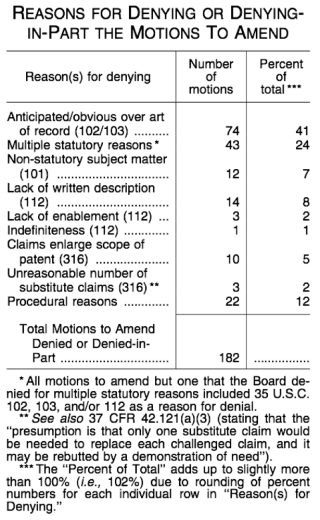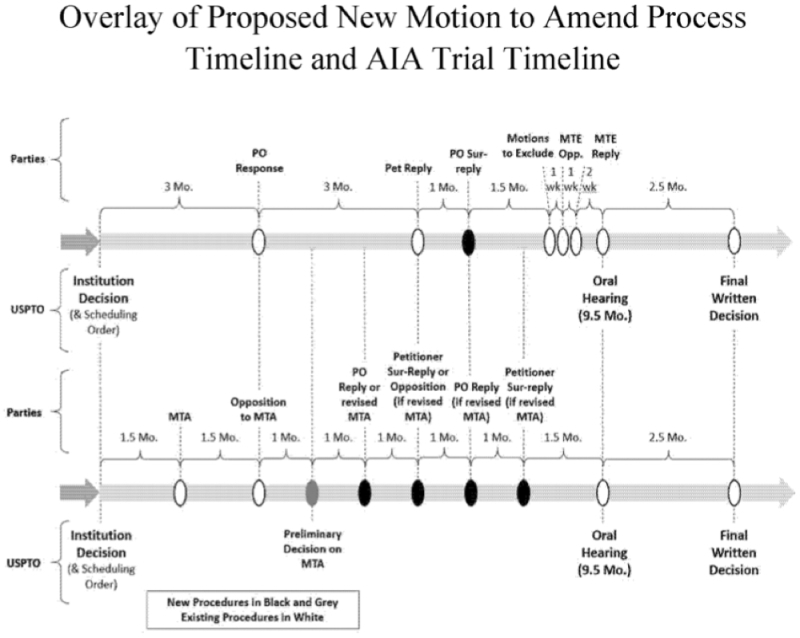
In AIA post-grant proceedings -- specifically, Post-Grant Review ("PGR"), Inter Partes Review ("IPR"), and Covered Business Method ("CBM") review -- the patentee has the right to seek to amend the claims rather than fight over the issued claims. However, in 90% of the cases in which a motion to amend has been decided by the Patent Trial and Appeal Board ("PTAB"), the motion has been denied. Based significantly on the dismal success rate of those motions to amend, the U.S. Patent and Trademark Office has now proposed an altered protocol for considering motions to amend in AIA post-grant proceedings. Specifically, it proposes having the PTAB provide a preliminary review of whether amended claims would satisfy statutory and regulatory requirements, then allowing the parties to react and a Patent Owner to potentially revise the motion to amend. Separately, the Office asked whether it should reallocate the burden of persuasion in motion to amend proceedings. Comments on these proposals are due by December 14, 2018.
Currently, the motion-to-amend process in PGR, IPR, and CBM reviews runs directly parallel to the substantive process: the Patent Owner must submit its motion to amend at the same time it files its Response (three months after institution), the Petitioner files its response to the motion to amend with its Reply to the Patent Owner's Response (three months later), the Patent Owner has an opportunity to reply in support of its motion to amend (one month later), and the issue is then decided in the Final Written Decision in which the PTAB resolves all of the other issues raised in the Institution Decision (twelve months after institution).[1] Applying that procedure, parties had filed 305 motions to amend as of March 31, 2018. The PTAB had ruled on 189 motions to amend by substituting claims (20 had requested simply cancelling claims, 35 found the original claims patentable or had already been decided, and 61 were withdrawn either by the party or by termination of the case). Of the motions to amend resolved by the PTAB, only 7 (4%) were granted and 11 (6%) were granted in part; 171 (90%) were denied.
The vast majority (88%) of the denials of motions to amend, either in whole or in part, was on statutory grounds:

In light of these circumstances, the Patent and Trademark Office has proposed a revised process that would decouple the motion to amend and substantive filings in AIA proceedings to allow a preliminary decision from the PTAB four months after institution and two and one-half months after the filing of a motion to amend. The Patent Owner would benefit by being able to address any statutory or procedural deficiencies in its Reply or a revised motion to amend; the Petitioner would benefit by getting the last word on any revised motion to amend. If the preliminary decision indicates that the original motion is likely to be denied, the Patent Owner would go first with a filing one month after the decision; if the preliminary decision indicates that the motion is likely to be granted, the Petitioner would go first. In fact, the process would potentially involve four additional briefs on the revised motion to amend (the revised motion, the Petitioner's response to the revised motion, the Patent Owner's reply in support of the revised motion, and the Petitioner's sur-reply). The PTAB would consider all of the briefs -- on both the original motion to amend and the revised motion -- and would not be limited to the arguments on the revised motion.
The Federal Register notice provided a helpful timeline of the proposed new motion to amend process, as compared to the existing practice:

The Patent and Trademark Office also asked whether it should reconsider the burden of persuasion in AIA proceedings, and proposed a process for dealing with recalcitrant Petitioners. The Office has never adopted a rule regarding the burden of persuasion on a motion to amend. The Federal Circuit held, in Aqua Products, Inc. v. Matal, 872 F.3d 1290 (Fed. Cir. 2017) (en banc), that it would be inappropriate to place it on the Patent Owner, stating:
The only legal conclusions that support and define the judgment of the court are: (1) The PTO has not adopted a rule placing the burden of persuasion with respect to the patentability of amended claims on the patent owner that is entitled to deference; and (2) in the absence of anything that might be entitled deference, the PTO may not place that burden on the patentee.
Id. at 1327. In response, the Office issued formal guidance indicating that the PTAB would no longer place the burden of persuasion on a Patent Owner.
A wrinkle arises, however, when the Petitioner stops participating in the AIA proceeding. In one such case, Bosch Auto. Servs. Sol'ns, LLC v. Matal, 878 F.3d 1027 (Fed. Cir. 2017), amended on reh'g (Mar. 18, 2018), the parties to the proceeding had settled. The Court first confirmed that "'the petitioner bears the burden of proving that the proposed amended claims are unpatentable by a preponderance of the evidence.'' Id. at 1040. The Court then indicated that the PTAB could deny the motion to amend only when the existing evidence would support that conclusion: "[W]here the challenger ceases to participate in the IPR and the Board proceeds to final judgment, it is the Board that must justify any finding of unpatentability by reference to the evidence of record in the IPR.'' Id. (quoting Aqua Products, 872 F.2d at 1311 (opinion of O'Malley, J.)).
In light of the Aqua Products and Bosch cases, as applied to PTAB proceedings in the informative decision Western Digital Corp. v. SPEX Techs., Inc. (IPR2018-00082 (Paper 13)), the Patent and Trademark Office is proposing a new rule for handling cases in which the Petitioner stops participating. Specifically, it has proposed giving the PTAB the discretion to solicit assistance from a patent examiner to develop the record on a motion to amend. The examiner would provide an advisory report that marshals the evidence and provides an assessment on patentability of amended claims without taking a position on any final legal determination.
The proposed changes to the motion to amend process may lack the elegance and simplicity of the current procedures, but they reflect a general agreement that the current procedures are not achieving the intended goal of the process. Thus, while the multiple rounds of briefing, and potential involvement of examiners, in the motion to amend process may add substantially to the administrative burden of motions to amend, they are likely to increase the likelihood of motions to amend being granted, thereby permitting the Patent Owner to obtain claims to which it is would be entitled in light of the arguments raised in the AIA proceeding.
[1] The parties may alter the dates for these filings (other than the Final Written Decision) by stipulation or motion. The can also agree to a schedule in which the motion to amend filings are not contemporaneous with the substantive filings. However, the presumption is the timeline set forth above.